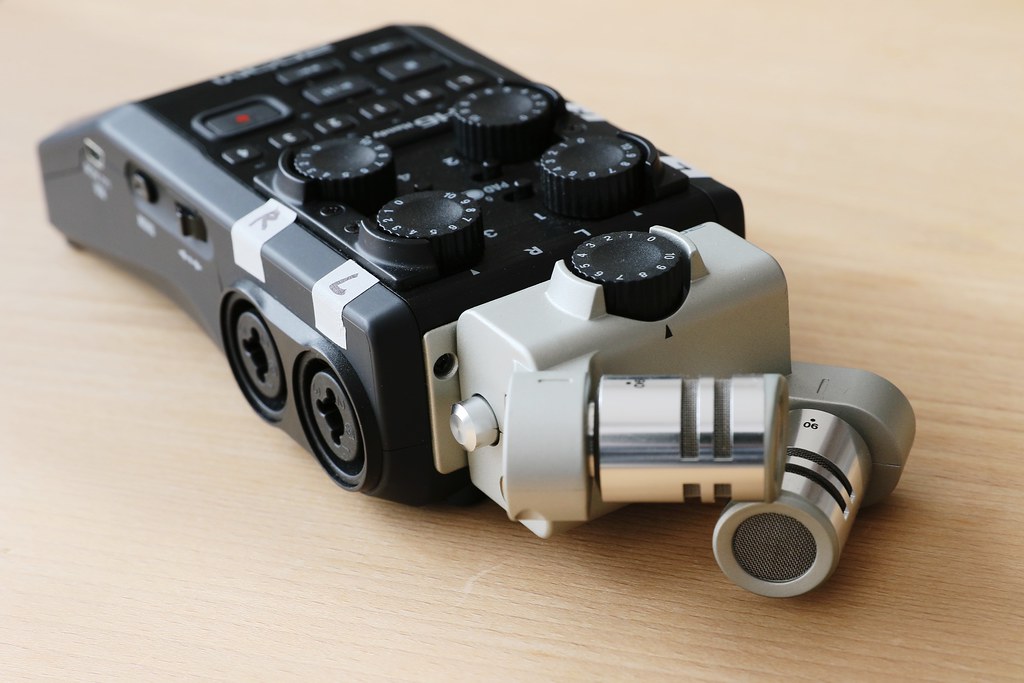When the Zoom H6 handy recorder debuted in 2013, it immediately became one of the most versatile portable recorders available. Everyone from location recorders to podcasters found the H6 to be a highly capable unit with features beyond its price and size. As we undergo a Zoom H6 review 8 years after release, we’ll decide if it still reigns as the go-to professional hand recorder.
What is the Zoom H6?
The Zoom H6 is a handheld portable recorder. You can capture up to 6 simultaneous channels of 24-bit/96kHz WAV audio. The unit comes with 4 hybrid XLR/1/4″ jacks with preamps for connecting your own mics. Each input has its own hardware dial to control the gain going in. Rounding out 6 total inputs are stereo X/Y and M/S microphone attachments on the front of the recorder. Luckily the H6 comes with its own mics for this purpose, but you can purchase a shotgun or dual XLR/TRS jack attachment accessory as well. Finally, the X/Y capsule can actually accept a 3.5mm secondary input for even more versatility.
Each input comes with independent phantom power, -20dB pads, and built-in effects like filtering, compression, and limiting. The Zoom H6 will even comes with auto-record, pre-record, and backup-record functionality, the latter of which can capture two -12dB tracks for safety from any of the inputs. As a proper field recorder, the H6 will run for approximately 20 hours off of 4 AA batteries.
As a powerful recorder on its own, the Zoom H6 can actually function as an audio interface as well. It’s possible to connect it straight to your DAW via USB, where you can record all 6 channels of audio with the Zoom in Multitrack mode. Just like a nice desktop interface, the device will also print any effects you have enabled, such as the high-pass filter (ranging from 80 to 150 Hz), and one of three compression presets, and one of two limiting presets.
While the 2-inch LCD screen is adequate for less detailed metering, some users may prefer to ‘see’ their audio on a larger screen. This is where USB connectivity comes incredibly handy; the Zoom now functions as a powerful, portable audio interface for your laptop, even if that’s not its primary purpose.
Complete Features
Here is a list of the most important features, courtesy of Zoom Corp:
- Swappable input attachments
- Recording up to 6 tracks at the same time
- 4 mic/line inputs with XLR/1/4″ jacks
- Gain dials and -20dB pads for each input
- Included X/Y capsule with secondary input through stereo 3.5mm Mic/Line In mini phone jack
- Phantom power for all inputs
- Full-color 2-inch LCD display for metering at a glance
- Records directly to SD, SDHC, and SDXC cards (up to 128GB)
- Records up to 24-bit96kHz audio in WAV or MP3 formats
- Auto-record, Pre-record, and Backup-record for safety
- Built-in effects, such as high-pass filtering, compression, and limiting
- Use it as a USB audio interface for PC/Mac/iPad
- Compatible with regular AA or NiMH rechargeable batteries
- Approximately 20 hours of operation with 4 AA batteries
Zoom H5 vs H6
The main difference between the H5 and H6 is number of inputs. The Zoom H5 is a 4-channel recorder; it has 2 XLR/TRS combo inputs as well as the stereo mic attachment. We’ve covered the H6’s 4 inputs, plus stereo attachment for a total of 6. As far as sound quality goes, the two units are the same, so there shouldn’t be any worries there. Understandably, the H6 is a bit bigger and heavier than the H5, so if portability is the top priority, the H5 is a winner.
Who purchases an H5 vs who purchases an H6 ultimately comes down to how many inputs are needed. A monologue podcaster doesn’t require 4 inputs; even the occasional guest is welcome with a Zoom H5. If you anticipate recording 4 simultaneous mics, then the H6 is clearly the only way to go.
Conclusion
A Zoom H6 review almost a decade after release still finds the handy recorder to be an incredibly versatile and powerful device. At just $329, it’s easily one of the most affordable ways to simply end up with 4 XLR/TRS preamps; 4+ channel audio interfaces usually run more than that, plus you get all the portability and flexibility of a field recorder. The Zoom H6 is still the perfect choice for entry-level audio recording or anyone who needs high-quality audio capabilities on-the-go.
